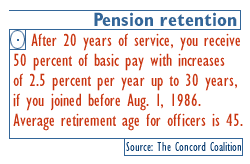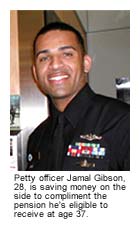|
At ease! It's time to retire
|
 |
March 10, 2000: 6:01 a.m. ET
Military workers who put in less than 20 years need to start planning now
By Staff Writer Jennifer Karchmer
|
NEW YORK (CNNfn) - When Ron Pearson joined the U.S. Navy 26 years ago, the military helped pay for his education at Rice University in Texas. During his career, he flew F-14s and fought in Vietnam.
Now retired and a financial planner, Pearson is glad he made it to the 20-year mark to collect his full pension benefits. But only a fraction of people serving in the military last long enough to qualify, and Pearson said it's crucial that they start looking at ways to maximize their retirement savings.
"It's difficult for some military personnel after five or six years who may be married, have kids and other financial obligations," said Pearson, 53, with Beach Financial Advisory Service in Virginia Beach, Va. "If they haven't banked some on the side, it's tough."
'Aim high'
Whether it's piloting F-14 jets, repairing radios on a submarine or working on an aircraft carrier, military employees must put in at least 20 years in the service before receiving full pension benefits. The military offers no employer-sponsored plan like the 401(k) plan that private companies offer, although legislation is in the works.
If you entered the armed forces before Aug. 1, 1986, you are entitled to a pension of 50 percent of your basic pay after 20 years of service, according to U.S. Department of Defense guidelines. Basic pay is a base salary that doesn't include allowances for housing and food. Pearson's gross salary when he retired was around $90,000 -- about half of that was his basic pay.
If you continue beyond 20 years of service, the pension increases by 2.5 percent of pay per year. At 30 years, you reach a 75 percent of base pay pension maximum.
 But 79 percent of officers and 92 percent of enlistees quit before becoming eligible for a pension, according to the nonprofit, nonpartisan group, The Concord Coalition. But 79 percent of officers and 92 percent of enlistees quit before becoming eligible for a pension, according to the nonprofit, nonpartisan group, The Concord Coalition.
"People consider it a very inequitable way to run a pension system," said Richard Jackson, an adviser to The Concord Coalition. "The vast majority in the military get nothing and the small group that stays for 20 years," receives a pension.
So how do you save for retirement if you're not a career military worker?
'Be all that you can be'
Jamal Gibson, a 28-year-old electronic technician with the U.S. Navy, is wondering that very question since he has another nine years until he's eligible to receive a military pension. He's married and has a young son, so he's got mortgage payments and a college fund on his mind.
Gibson knows he'll have to rely on his own savings and is considering an IRA like many of colleagues have. Now, at least, he's putting away some money in a bank savings account.

"It's a penny in the bucket," Gibson said. "I believe everyone should start (saving) as soon as possible."
'Let the journey begin'
So now's the time to put together a financial plan whether you're a career military worker or you serve for a short time.
1. Create an emergency fund. Financial experts suggest having at least three months of expense money saved in a bank or money market account.
2. Save 10 percent of your take home pay. If you plan on retiring from the military in a year or two, open a money market account, which usually yields about 5 percent and is easily accessible. If you plan on serving for another five years, you may want to be a little more aggressive by investing in a mixture of equities and bonds. For longer than 10 years, Pearson suggests an even riskier allocation that includes international fund exposure.
3. Open IRA plans for both you and your spouse. Contribute the maximum $2,000 per person, if you can. Pearson suggests a Roth IRA for anyone with a long time horizon who expects to be in a higher tax bracket when it's time to withdraw the money. "You don't get the tax break today under the Roth IRA, but when you retire you won't pay taxes then," he said.
4. Maximize your spouse's 401(k) plan. Contribute as many pretax dollars as possible to your spouse's employer-sponsored plan. Your spouse will end up with less take-home pay, but you can rely on your own paycheck for the bills now while the retirement account grows.
5. Seek out free military services. The military usually offers free legal assistance to help you write wills and other estate documents. Take advantage of these services now while you're still on the force.
"People don't think about retirement at age 17 or 23," said Gibson, who works at the armed forces recruiting office in New York's Times Square. "They think more: 'How can I get that BMW now?' "
'Semper fidelis: always faithful'
For military workers who make a career of their duty, retiring from the service often means jumping into a second occupation at a relatively young age to boot.
Pearson, the financial planner in Virginia Beach, realized he enjoyed crunching numbers and following the markets after a friend introduced him to the profession in 1994 when he was 48 -- much too young to collect Social Security benefits.
And Bruce Howard, who retired from the Navy in September 1999 at age 53 after more than two decades of administrative tasks alongside commanding officers, now serves as a public affairs officer for the Navy on a contract basis.
The transition to a second career can be a bumpy ride, but Howard is taking it in stride.
"The hardest thing I have to decide is what to wear tomorrow," Howard said jokingly, since now he isn't required to wear a Navy uniform. 
-- Click here to send email about this story to Staff Writer Jennifer Karchmer.
|
|
|
|
|
 |

|

